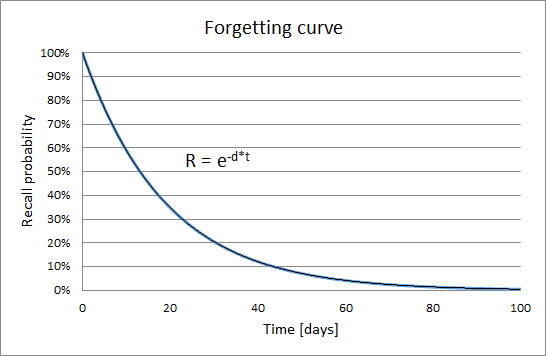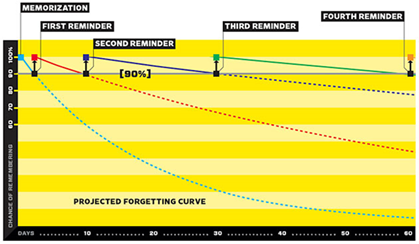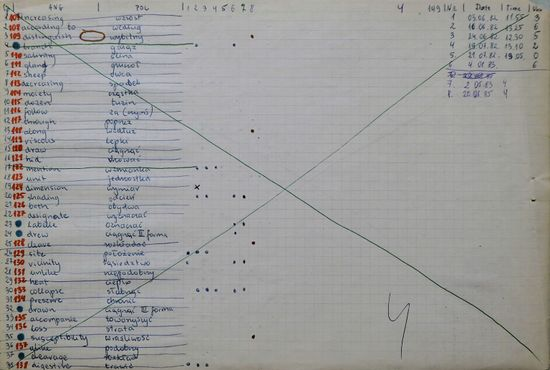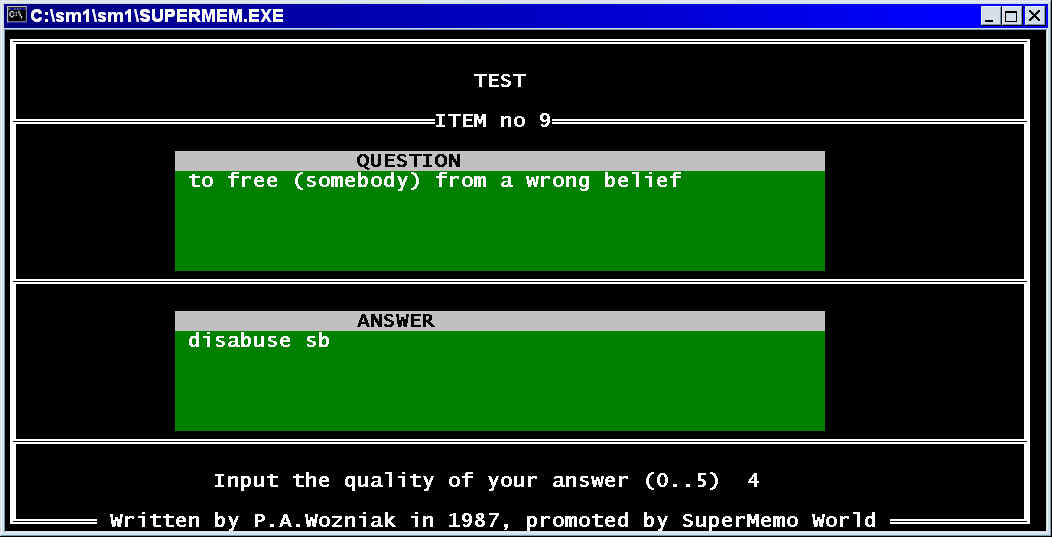What is the SuperMemo spaced repetition method?
The SuperMemo method, which is the basis of all our courses, was created in the ‘80s by Piotr Woźniak — a young, talented scientist and student of molecular biology who needed an effective way to learn biochemistry and … English vocabulary. In 1991, we became the first company in the world to start using spaced repetition to aid learners and provide them with a better memorisation process. Today, our solution is still an inspiration for almost the entire education industry.
How can you memorise things quickly and effectively? Learning with the SuperMemo method step by step:
- Start a course from the LEARN section — by learning new material.
- After each card, evaluate the degree to which you have learned a word or rule using the buttons: I KNOW, I DON’T KNOW, ALMOST.
- The SuperMemo algorithm uses this information to select the best moments for you to repeat small portions of information — that is, when you almost start to forget them. It then arranges them appropriately in the REPEAT section.
- The better you remember given information, the longer intervals the algorithm sets between each repetition, and your knowledge is gradually consolidated in long-term memory.
TIP: Remember that spaced repetitions are the basis of permanent and fast memorisation using the SuperMemo method. Your learning progress depends on them. If you have a bad day, when you lack the strength and will, skip learning new cards and focus on the REPEAT section instead. Doing even a few repetitions will be a step forward!
How exactly does it work?
Let’s start with the basics — what is the forgetting curve and how did it impact the SuperMemo method?
Let’s be honest — we all forget, and the information that we don’t use daily or regularly goes under the knife in the first place. The forgetting curve is a chart where you can observe how the chances of remembering previously memorised information decrease over time. The knowledge that we can use without problem immediately after learning quickly disappears from our memory, until finally the ability to recall it drops to almost zero. Most of us will recognise this phenomenon from … studying for exams (who among us didn’t try to memorise 6 months of lectures in just one night?).

There is also good news — the ability to recall given information will be dropping mercilessly and quickly … until the next repetition. After that, all the fun with the forgetting curve begins anew, but this time it will take you longer to forget the information again.
Of course, there isn’t a single, universal shape of the forgetting curve — it depends on the individual predispositions of each learner, the amount of study material, and even the time of day. It is also worth mentioning that how effectively we remember given information depends strongly on how well it fits into our inner network of associations and connections — that is, the information already present in our brain. The better the fit, the easier it is to learn. This is why it is usually quite difficult when you start learning a new language. However, it is worth getting through a tougher beginning, because later the whole learning process becomes easier and much more pleasant.
LEARN MORE
Interested in the forgetting curve? Check out the article “The forgetting curve and repetition – why forgetting is an important part of learning”, written by our CEO, Krzysztof Biedalak.
Understanding spaced repetition — how does it work?
The idea of spaced repetition is to set repetitions at specific intervals, which allows us to minimise their number, and thus learn faster. What do these intervals depend on? First, on our individual pace of remembering and learning — every person has their own predispositions. However, there are several rules regarding long-term memory, thanks to which the SuperMemo method turns out to be really effective. How do they impact spaced repetition? Let’s look at the chart below:

On the chart, first you can see the forgetting curve from the previous section — the first time you remember a piece of information, it flies from your memory quite quickly, and within a short time after you finish learning. But with each repetition, the chance of remembering information over time increases, so the intervals between the reminders become longer.However, we should remember that if we forget a given piece of information completely, we have to start the entire repetition process from scratch. That is why it’s so important to start with short intervals and gradually increase them. Finally, let’s quote one of the rules regarding long-term memory:
The later you do another effective repetition, the more its stability will increase.
This means that the later the date of repetition is set, the better the material will be memorised. But there’s a catch — you must not completely forget what you’re learning before then. That is why the basis of spaced repetition and the SuperMemo method is to set repetitions at a later moment, but one in which the information is still highly likely to be remembered (approx. 90%). The SuperMemo algorithm looks for such moments in our application by analysing your pace of remembering and learning progress.
LEARN MORE
Interested in spaced repetition? Check out the article “Spaced repetition in learning — how does it work?” written by our CEO.
Myths about Ebbinghaus and his forgetting curve
When it comes to repetitions and remembering, one person usually pops up in the discussion — Hermann Ebbinghaus, a German psychologist born in 1850, one of the most famous authors of one of the first pieces of research on memory. But the internet is full of conflicting claims and misinformation, and that’s why it’s important to remember that Ebbinghaus didn’t invent spaced repetition. However, he was the first to analyse a very important subject — the relationship between the level of remembering and the passage of time (for a very specific type of information, which you will learn about in a moment).
The psychologist’s research consisted of memorizing a series of artificial syllables, e.g. KAZ, LEZ, GEC, which did not evoke any associations or emotions. That made them something completely new and more difficult to memorise for the learner. Ebbinghaus measured mainly the time and the number of repetitions needed to remember each series of syllables over time. He then compared the time needed to remember a completely new series of syllables with the time needed to re-learn a series that had already been forgotten. The data presented in his research was used to create the first-ever forgetting curve.
Ebbinghaus’s data, however, was somewhat “out-of-touch”, partly because the memorised information was completely artificial and not useful in everyday life, and, as already mentioned, lacked any logical and emotional connections. And we all know that even if we are just starting to learn, say, a language, in the process we acquire more and more information which, over time, we are able to put into a certain network of connections. We also often use mnemonics. Moreover, the German scientist used only one type of data, arranged in series of the same length. We simply don’t know how his research would work with any other type of information — e.g. English words. Meanwhile, the basis of spaced repetition is the ability to adjust it individually to the learner and type of information. Finally, it is worth mentioning that Ebbinghaus himself did not present his forgetting curve — it was recreated on the basis of the results and numerical data from the experiment. However, this curve has little to do with the charts presented in the press and on the Internet. Those are the achievements of Dr. Piotr Woźniak, the official creator of the SuperMemo method.
Hermann Ebbinghaus’s research was “shelved” over the next hundred years, and not considered a scientific breakthrough at all. Only a few scientists and practitioners took on further experiments with memory and repetitions. The real breakthrough came in the 1980s, when a young molecular biology student, Piotr Woźniak, decided not only to discover the correct pattern of remembering, but also to use a computer to predict the optimal time for subsequent revisions for him.
LEARN MORE
Interested in Ebbinghaus’s research? Check out the articles: ”Did Ebbinghaus invent spaced repetition?” and “Ebbinghaus and the forgetting curve — a few facts about the experiments and research of the German psychologist”, written by our CEO.
Who developed spaced repetition? Story time!
Let’s move to the year 1982. Piotr Woźniak, an ambitious student of Adam Mickiewicz University in Poznań, was feeling more and more overwhelmed and frustrated by the amount of study material. What bothered him even more was that everything slipped out of his mind right after each exam. He decided to change it, starting by taking notes on biochemistry and English. He wrote down all the necessary information on cards, in the form of questions and answers. He studied them at irregular intervals, each time noting the date of repetition and any information he failed to remember. In this way, he developed his first principles of effective knowledge formulation. After some time, he noticed that each repetition had its own “life cycle” (a specific amount of time for which the repeated information is retained in memory) and an impact on the persistence of remembering. On the basis of loose data from his research, the young student created the first version of his original forgetting curve.

In 1985, Piotr Woźniak decided to go one step further and began a series of experiments, using English vocabulary. This time, he focused mainly on catching and measuring errors during a series of repetitions, separated by intervals of different lengths. Thanks to this, he discovered that after each repetition the interval becomes longer without the risk of forgetting the word. And that’s how the very first version of the SuperMemo method was created — on paper.
That same year, Woźniak began his IT studies at the Poznań University of Technology and bought his first computer, ZX Spectrum. He bought it second-hand from someone convinced that they are selling … “just a keyboard”. There is only one problem — the ZX Spectrum required the data to be uploaded on an audiotape. This limited the young scientist’s options but didn’t stop him from continuing his research. In 1987 his family decided to help financially, thanks to which Piotr Woźniak finally acquired a PC with a hard drive. In December, three months after the purchase, he launched the first SuperMemo application. It operated using a modified version of the SuperMemo algorithm (called SM-2), which assigned a specific level of difficulty to each piece of information and used this analysis to select the appropriate intervals between repetitions. The SM-2 is still an inspiration for many replay applications to this day — it is used, among others, by Anki, and formerly by Quizlet.

SuperMemo 1.0
But Piotr Woźniak didn’t stop there — over the next few years, he kept creating new versions of the algorithm, improving its accuracy and fitting it to the material and the student’s predispositions. His many years of research on human memory became the basis of numerous master’s and doctoral theses, including his own. For the SuperMemo method, he received many awards and publications in prestigious magazines, such as Wired and The Guardian.
In this extraordinary story we also have to mention the year 1991, when Piotr Woźniak and his friend, Krzysztof Biedalak, started the SuperMemo World company, dedicated to the development and distribution of the SuperMemo application. Its mission? To provide each person with the possibility of effective, enjoyable learning and acquiring useful skills that will last. That is why the SuperMemo method is the basis of our offer. Soon after that, the company focused on providing original language courses. 30 years later, we’re still trying to continue our mission — we are constantly working on the development of the method and our course offer.
LEARN MORE
Get to know the history of SuperMemo with all the spicy details! Check out the articles: “The true history of spaced repetition” (pl. prawdziwa historia inteligentnych powtórek), written by Piotr Woźniak himself, and ”Who invented spaced repetition? The history of the SuperMemo method” , written by Krzysztof Biedalak.